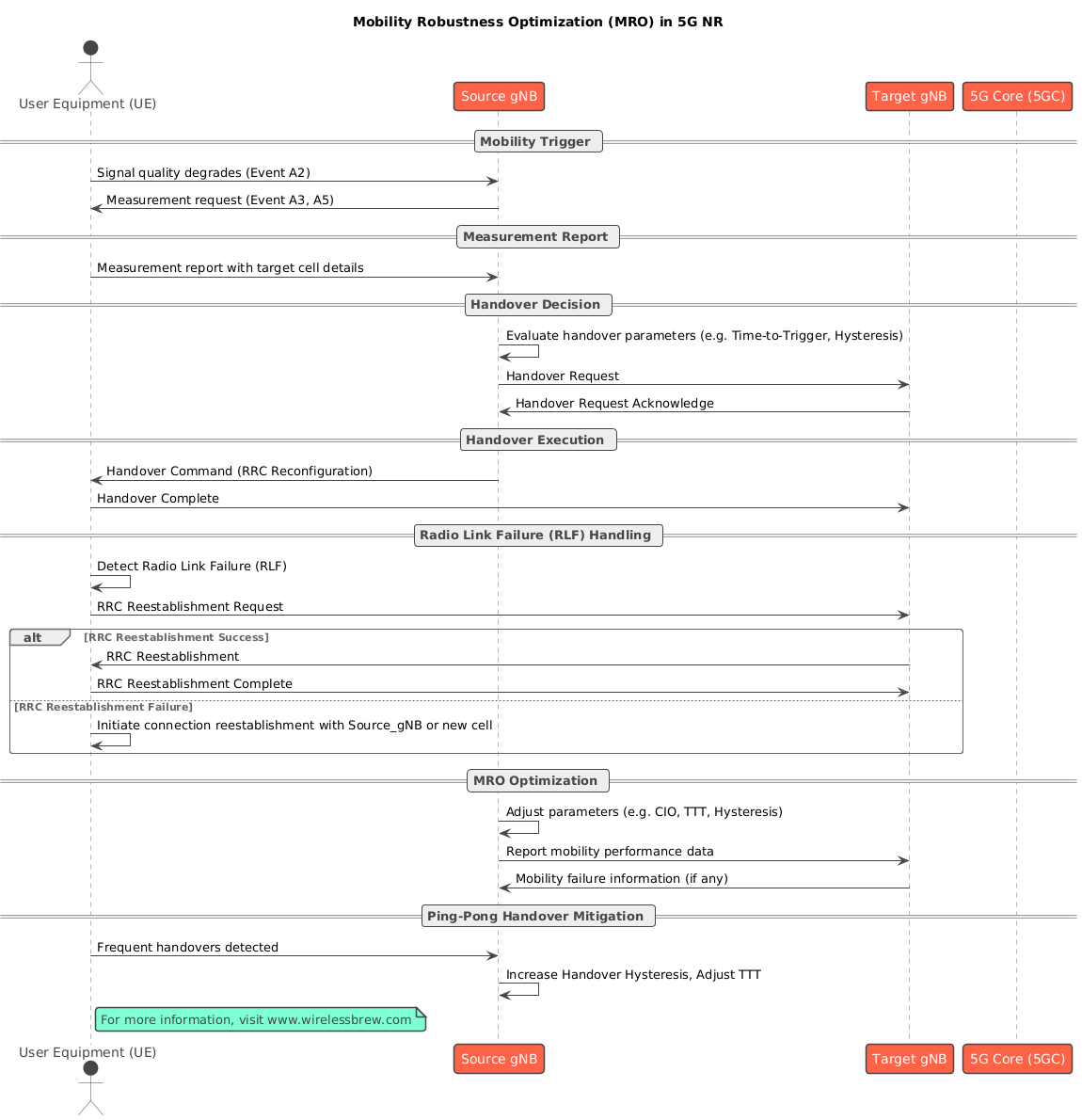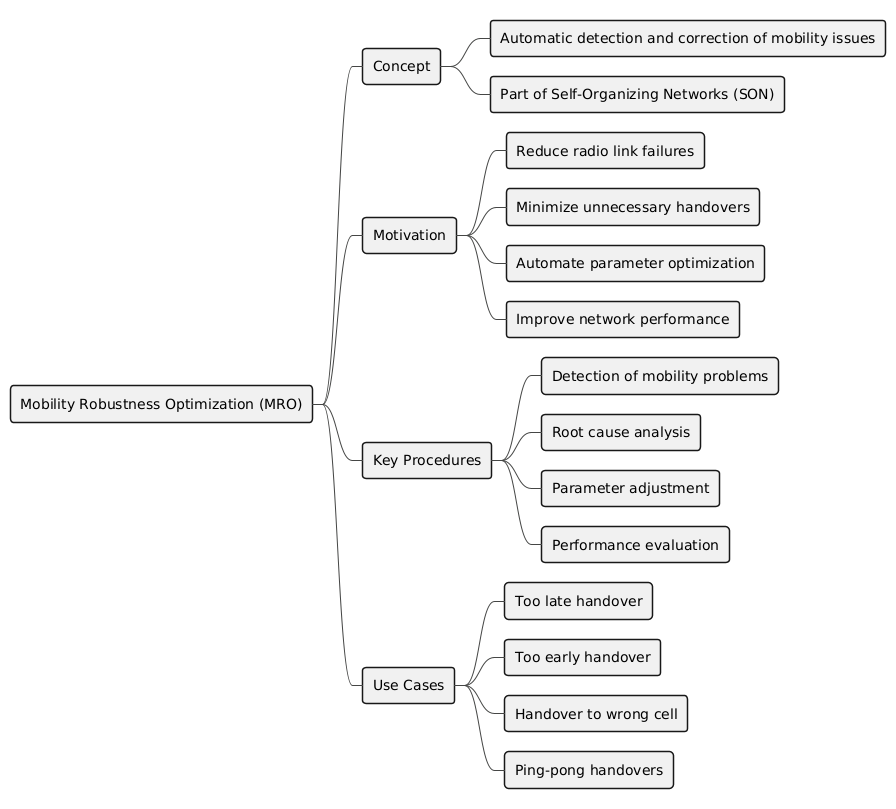Mobility Robustness Optimization (MRO) is a critical feature in 5G NR designed to enhance handover performance and minimize mobility-related failures. Mobility management is essential for providing seamless user experience as UE’s move across cell boundaries in the mobile network. MRO focuses on optimizing handover parameters and configurations to prevent Radio Link Failures (RLF), minimize Handover Failures (HOF), and reduce Ping-Pong effects in handover scenarios.
In 5G NR, the 3GPP has standardized various MRO techniques to achieve reliable mobility performance. These techniques are outlined in 3GPP Release 15 and subsequent releases, with specific focus on reducing mobility-related issues and enhancing network efficiency. MRO operates in both closed-loop and open-loop modes, using real-time network feedback and pre-configured parameters to optimize handover decisions. It continuously monitors network performance metrics and automatically adjusts the mobility parameters to improve handover success rates and reduce mobility-related failures.
Components of MRO in 5G NR
MRO consists of several components, each targeting specific mobility challenges:
- Handover Failure (HOF) Reduction
- Radio Link Failure (RLF) Prevention
- Ping-Pong Handover Mitigation
- Cell Reselection Optimization
Each of these components relies on optimized signaling, measurement reports, and mobility events to prevent unnecessary disruptions in the user experience.
Handover Failure (HOF) Reduction
Handover failure occurs when the UE cannot establish a connection with the target cell during a handover procedure. To address this, the network utilizes various handover parameter tuning methods defined in 3GPP TS 38.331. These include:
- Adjusting the Time-to-Trigger (TTT) parameter to delay or expedite the handover process based on UE conditions.
- Configuring Event A3 and Event A5 measurements for early detection of deteriorating link quality, prompting faster handover initiation.
- Dynamically modifying the handover hysteresis to minimize false handovers and improve decision accuracy.
The MRO algorithms can trigger reconfiguration messages to UEs, dynamically adjusting handover parameters based on real-time network performance data.
Radio Link Failure (RLF) Prevention
RLF occurs when the signal quality between the UE and the serving cell deteriorates beyond recovery, leading to connection loss. The network can prevent RLF through enhanced monitoring of the RLF triggers, which are specified in 3GPP TS 38.300. Some of the measures include:
- Threshold-based RLF detection: The UE continuously monitors signal quality metrics such as Reference Signal Received Power (RSRP) and Reference Signal Received Quality (RSRQ). When these metrics fall below predefined thresholds, the network triggers corrective actions.
- Optimized Cell Individual Offset (CIO): The CIO parameter can be tuned dynamically to optimize the handover margin between cells, preventing RLF due to poor coverage or interference.
These mechanisms allow the network to anticipate potential RLFs and execute proactive measures such as handover to a better cell or requesting the UE to perform a re-selection.
Ping-Pong Handover Mitigation
The Ping-Pong effect refers to the rapid back-and-forth handovers between two or more cells, which negatively impact the user experience. 3GPP TS 38.133 outlines various techniques for mitigating this effect:
- Hysteresis adjustment: The network can increase the handover hysteresis values, preventing the UE from triggering unnecessary handovers.
- Mobility state detection: The UE monitors its speed and mobility state (stationary, medium-speed, high-speed) and reports these parameters to the network. Based on this information, the network can adjust handover criteria to avoid frequent handovers in high-mobility scenarios.
- TTT tuning: Increasing the Time-to-Trigger parameter allows the UE to remain connected to the serving cell longer, avoiding premature handovers.
Cell Reselection Optimization
For UEs in idle mode, cell reselection is the primary mobility procedure. 3GPP TS 38.331 specifies that the UE performs cell reselection based on ranking criteria that include RSRP, RSRQ, and signal quality thresholds. MRO optimizes the reselection parameters to ensure that the UE connects to the best available cell, especially in dense network environments or high mobility situations.
Key Performance Indicators (KPIs) for MRO in 5G NR
To measure the effectiveness of MRO in 5G NR, several KPIs are monitored by the network:
- Handover Success Rate (HSR): This indicates the percentage of successful handovers out of the total handovers attempted. A high HSR reflects effective MRO performance.
- Radio Link Failure Rate (RLF Rate): The number of RLFs per unit of time or per session, which MRO aims to minimize.
- Ping-Pong Rate: This measures the number of unnecessary handovers between cells, which MRO strives to reduce.
- Call Drop Rate (CDR): The number of dropped calls due to handover failures or RLFs, which is another critical metric for assessing MRO efficiency.
Self-Optimization of MRO Parameters via SON
MRO is closely integrated with Self-Organizing Networks (SON) functions, where the network autonomously adjusts mobility-related parameters. SON algorithms continuously analyze performance data and apply corrective actions without human intervention. SON-based MRO ensures that handover thresholds, hysteresis, and CIO values are optimized in real time, improving overall mobility performance.
MRO Process Flow
- Monitoring: The system continuously monitors mobility events such as handover attempts, handover successes, and failures (HOFs, RLFs).
- Detection: MRO algorithms detect potential problems such as frequent HOFs, RLFs, or abnormal handover patterns like ping-ponging.
- Analysis: The network collects performance data and analyzes the root cause of the issues. This analysis may involve signal quality measurements (e.g., Reference Signal Received Power (RSRP) or Reference Signal Received Quality (RSRQ)) and handover-related signaling.
- Optimization: Based on the analysis, MRO adjusts the relevant mobility parameters. This can involve modifying handover trigger thresholds, TTT, hysteresis, or reselection criteria to prevent future issues.
- Implementation: The network applies the new parameters to improve mobility performance and ensure better handover success rates.
Key Parameters Optimized by MRO
- Time-to-Trigger (TTT): The time duration that the UE’s signal quality needs to meet a handover threshold before a handover is triggered.
- Handover Margin (Hysteresis): The margin by which the target cell’s signal strength must exceed that of the source cell before handover is initiated.
- Event A3: The main handover triggering event where a UE initiates a handover when the target cell signal quality becomes better than the source cell by a defined offset (A3 offset).
- Event A1/A2: Events related to entry and exit thresholds for signal strength, used to determine when the UE should remain connected to the serving cell or prepare for cell reselection.
MRO in 5G NR
In 5G NR, MRO becomes even more critical due to:
- Beam-based Mobility: In 5G, the network often operates in beamforming mode, and UEs may need to switch between different beams within the same cell, as well as across different cells. MRO optimizes the handover between beams to prevent frequent beam-switching issues.
- Dual Connectivity (DC): When UEs are connected to both LTE (as the anchor) and NR (for higher throughput), MRO optimizes handovers across dual connectivity links.
- Ultra-Dense Networks: In 5G, with a higher density of small cells, MRO becomes crucial to prevent frequent handovers between neighboring small cells and ensure efficient mobility across macro and small cells.
Benefits of MRO
- Reduced Handover Failures: By optimizing handover conditions, MRO reduces the number of dropped calls and failed handover attempts.
- Improved User Experience: MRO ensures smooth transitions between cells and improves the overall quality of service, especially during mobility.
- Reduced Network Load: Fewer handover failures and optimized mobility mean less signaling overhead, leading to improved network efficiency.
Mobility Robustness Optimization (MRO) in 5G NR is crucial for ensuring seamless handovers and reliable mobility management, particularly in dense urban environments or high-speed scenarios. By leveraging sophisticated handover algorithms and real-time network data, MRO minimizes mobility-related issues such as handover failures, radio link failures, and Ping-Pong effects. Through ongoing advancements in 3GPP specifications, MRO will continue to evolve and support the growing demands of 5G NR networks.
For further details, please refer to the following 3GPP documents:
- 3GPP TS 38.300: Overall architecture and principles for NR.
- 3GPP TS 38.331: Radio Resource Control (RRC) protocol specification.
- 3GPP TS 38.413: NG-RAN application protocol for mobility.
- 3GPP TS 38.133: Requirements for RRM in mobility scenarios.


